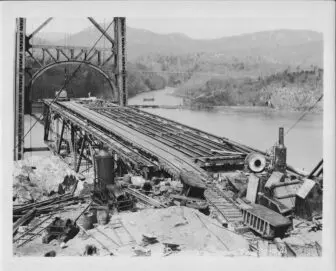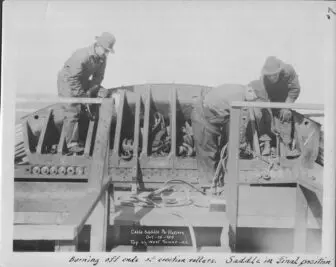Crossing was briefly longest suspension bridge
In November 2024, the Bear Mountain Bridge will mark 100 years of operations, but the party began on April 20 of this year with the dedication of a time capsule in honor of the start of construction a century ago.
The iconic structure, now operated by the New York State Bridge Authority with its maintenance paid entirely by tolls, took only 20 months to complete, without a single fatality.
At the time, it was a construction and engineering feat of global significance. Not only was it the first bridge to have a concrete deck and the first crossing over the Hudson River south of Albany, it was the world’s longest suspension bridge, with a main span of 1,632 feet and an overall length of 2,255 feet.

The main cables, supported by two 361-foot-high towers, vividly illustrate the enormity of the project. They typically barely earn a second look from drivers because, at a distance, their size is deceptive. A closer look reveals cables that total 2,600 feet in length, nearly half a mile. Each is 18 inches thick and made up of 7,452 wires.
The Specs
Type: Parallel wire cable suspension
Length: 2,255 feet
Tower height: 361 feet
Construction began: March 1923
Opened: Nov. 27, 1924
Designer: Howard C. Baird
Builder: Terry and Tench Construction
Cable designer: John A. Roebling and Sons
Height above river: 155 feet
Original cost (including goat trail): $4.75 million ($84 million)
Estimated replacement cost: $166 million
Today, the Bear Mountain Bridge is often described as beautiful. That was not always the case. Before construction began, there was concern it would tarnish the natural beauty of the Highlands. A July 1923 New York Times editorial, headlined “An Infliction of Ugliness on the Hudson,” asserted that plans for the bridge were “wholly out of accord with the scenery around it and indicative only of a desire on the part of the builders to make it as cheaply as they can.”

The Times was apparently referring to an outdated plan, because the designers were already revising the appearance to include arches for aesthetic appeal. Among Hudson River bridges, its design offers the most unobstructed views.
Discussion of a bridge began in earnest in 1869 when the Hudson Highland Suspension Bridge Co., created a year earlier by an act of the state Legislature, proposed a suspension bridge from Fort Clinton to Anthony’s Nose to help coal and iron reach New England. The initial design called for an upper-deck railway and a lower-deck roadway.
Construction was expected to take six years but the complex terrain and financial difficulties caused delays. The company reorganized in 1896 but its charter lapsed in 1916 with only basic foundation work completed.

In March 1922, the Bear Mountain Hudson River Bridge Co. was authorized by the state to build an automobile bridge with a 3-mile approach from the Albany Post Road north of Peekskill. Today that road is informally known as “the goat trail.”
The company board included E. Roland Harriman, son of railroad magnate Edward H. Harriman. The family was instrumental in the funding, said Kathryn Burke, director of Historic Bridges of the Hudson Valley and the author of Hudson River Bridges.
The increasing popularity of Bear Mountain State Park helped fuel the need for the bridge, she said. Before construction was complete, “the only way to visit the park from the east side of the Hudson was by boat.” Automobiles were becoming more affordable, and people wanted to drive.
The bridge was dedicated on Nov. 26, 1924, and opened for traffic the next day.
A toll house on the goat trail served as a home for the assistant bridge manager; it was added to the National Register of Historic Places in 1982 and is now a visitor center. The bridge manager lived in the stone building at the west entrance; that building is now an office.
When the New York State Bridge Authority acquired the Bear Mountain Bridge in 1940, it lowered tolls from 80 cents to 50 cents each way. The car ferries, unable to compete, ceased operations in 1941. The bridge’s toll was further reduced to 35 cents in 1942 and to 25 cents in 1945.
Today, tolls are collected only in the eastbound direction on all Hudson River vehicle bridges operated by the authority. Manual collection was eliminated in 2021 and payments are cashless, with tolls starting at $1.65.
Traffic on the bridge has increased dramatically over the years. In 1940, there were 143,417 crossings. In 2022, there were nearly 7.6 million.
Construction of the Bear Mountain Bridge kicked off a golden age of bridge building. Its reign as the world’s longest suspension bridge lasted only two years, until the completion of the Benjamin Franklin Bridge in Philadelphia in 1926. That was surpassed by the Ambassador Bridge in Detroit in 1929, the George Washington Bridge in 1931 and the Golden Gate Bridge in 1937. The longest suspension bridge today is the Çanakkale Bridge in Turkey, which opened in 2022 and stretches 15,118 feet over the Dardanelles.
The time capsule dedicated in April is stored in a climate-controlled building near the bridge. It contains letters from Gov. Kathy Hochul and Lt. Gov. Antonio Delgado, bridge commissioners, Putnam and Orange county officials and letters from 90 fourth graders at Hillcrest Elementary School in Peekskill. There are also toll-collector badges, boots, a COVID face mask and a block used in the making of a sculpture of the late Supreme Court Justice Ruth Bader Ginsburg.
The Roebling Museum in Roebling, New Jersey, donated a leatherbound copy of a study done on the wire cables, Burke said, and the Harriman family gave a proclamation signed by President Gerald Ford thanking Roland Harriman for his years as head of the American Red Cross.
The capsule will be opened in 2124 for the bridge’s 200th anniversary.

